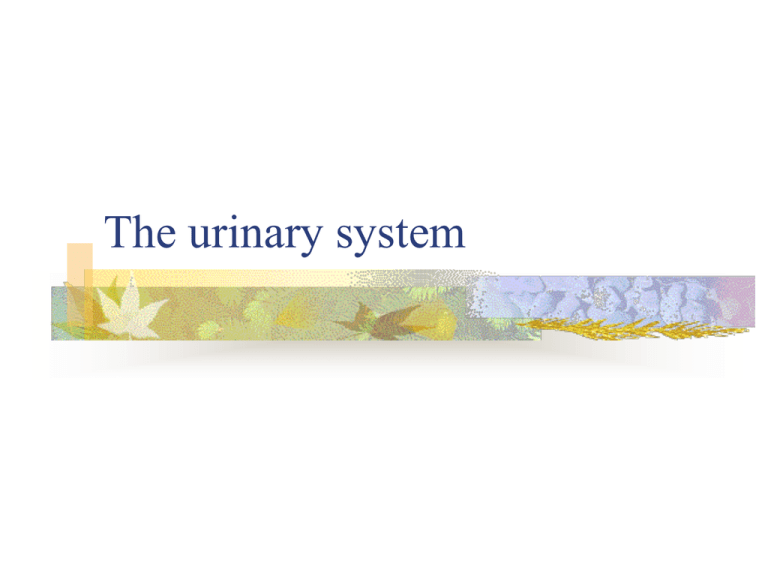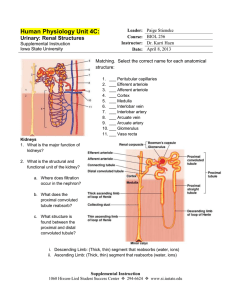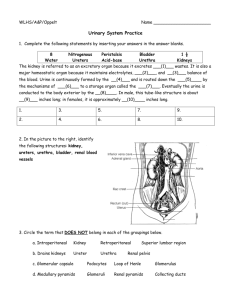Anatomy & Physiology
advertisement

The urinary system The urinary system The urinary system consists of two kidneys, two ureters, one bladder and one urethra. Urine is formed in each of the kidneys as waste product from blood filtration and passes through a ureter through to the bladder Renal Structure About 1cm of the outside of the kidney is called the renal cortex layer. The inside of the kidney is called the medulla and it is here that blood is filtered. The medulla is composed of between 8 and 18 renal pyramids and you can see a representation of these in this slide. You can also see how urine drains into the ureter Renal Pyramid Each renal pyramid has many thousand nephrons. You can see a representation of one in this slide. Blood enters the glomerulus where filtration commences. It is labelled “G” in this slide. The filtrate then passes through the Proximal convoluted tubule then down the thin descending limb of Henle’s loop, then through the Distal convoluted tubule), the Collecting tubule and finally into the Collecting duct. We will look at the microscopic structure in each of these structures to come to terms with urine formation The nephron This slide also shows a nephron and you can see how different substances are reabsorbed back into the blood during urine formation. Essentially, urine is on the inside of the tube in this diagram and its composition varies as it passes down through the tube until it comes to the collecting ducts where its composition has been finalised Glomerulus (Renal Corpuscle) First point of blood filtration is in the glomerulus. It is a tuft of capillaries. Blood enters via afferent arteriole and leaves via efferent arteriole. Plasma is filtered into Bowman’s space across the networked capillaries. The filtrate flows into the Proximal Convoluted Tubule. You can note that these cells have cilia on them. Filtered plasma passes back into the efferent arteriole whilst the filtrate containing much of the liquid component of blood flows out of the glomerulus into the proximal convoluted tubule. No protein should be present in filtrate Proximal Convoluted Tubule The Proximal convoluted tubule is lined by cuboidal epithelium most of the water that was filtered out of the blood now passes across the epithelial layer and back into the blood. The epithelial membrane contains special enzymes that can digest any peptides present so amino acids are not lost into the urine Loop of Henle Urine now passes through the Loop of Hele, which consists of thin walled tubules. Much of the salt in the urine is reabsorbed back into the blood by active transport Distal Convoluted Tubules The Distal convoluted tubule contains numerous mitochondria to provide ATP for active transport of sodium back into interstitial fluid. Collecting Ducts Finally urine passes through the collecting ducts. These ducts are very important because of their role in regulating the amount of urine formed Proximal Ureter The urine now flows from the kidney into the ureter. This is lined by transitional epithelium, fibroelastic lamina and circular smooth muscle, which helps move the fluid into the bladder. Bladder The bladder has a thick muscular wall, a thin layer of smooth muscle and is lined by transitional epithelium. The transitional epithelia change shape as the bladder distends






